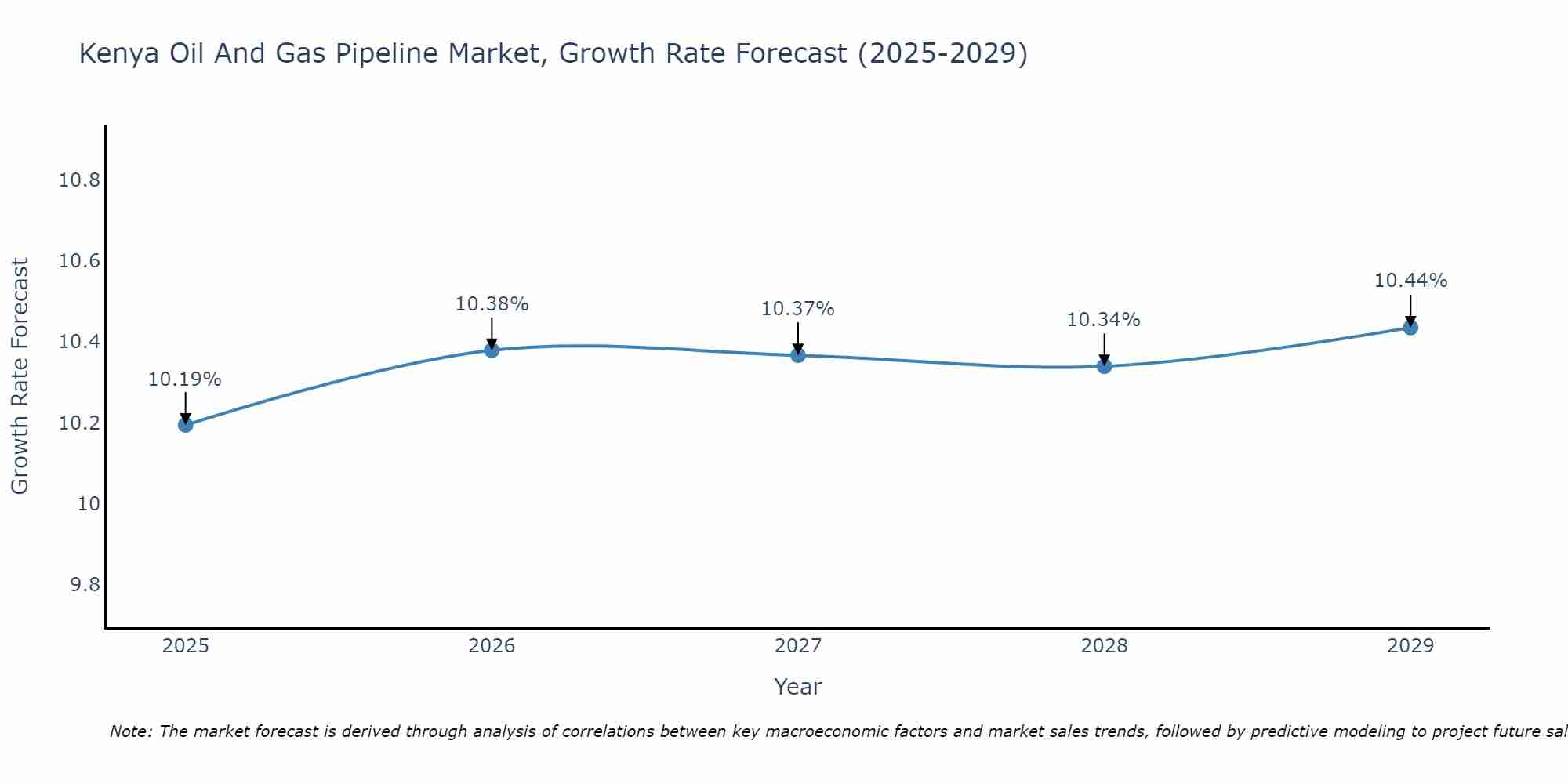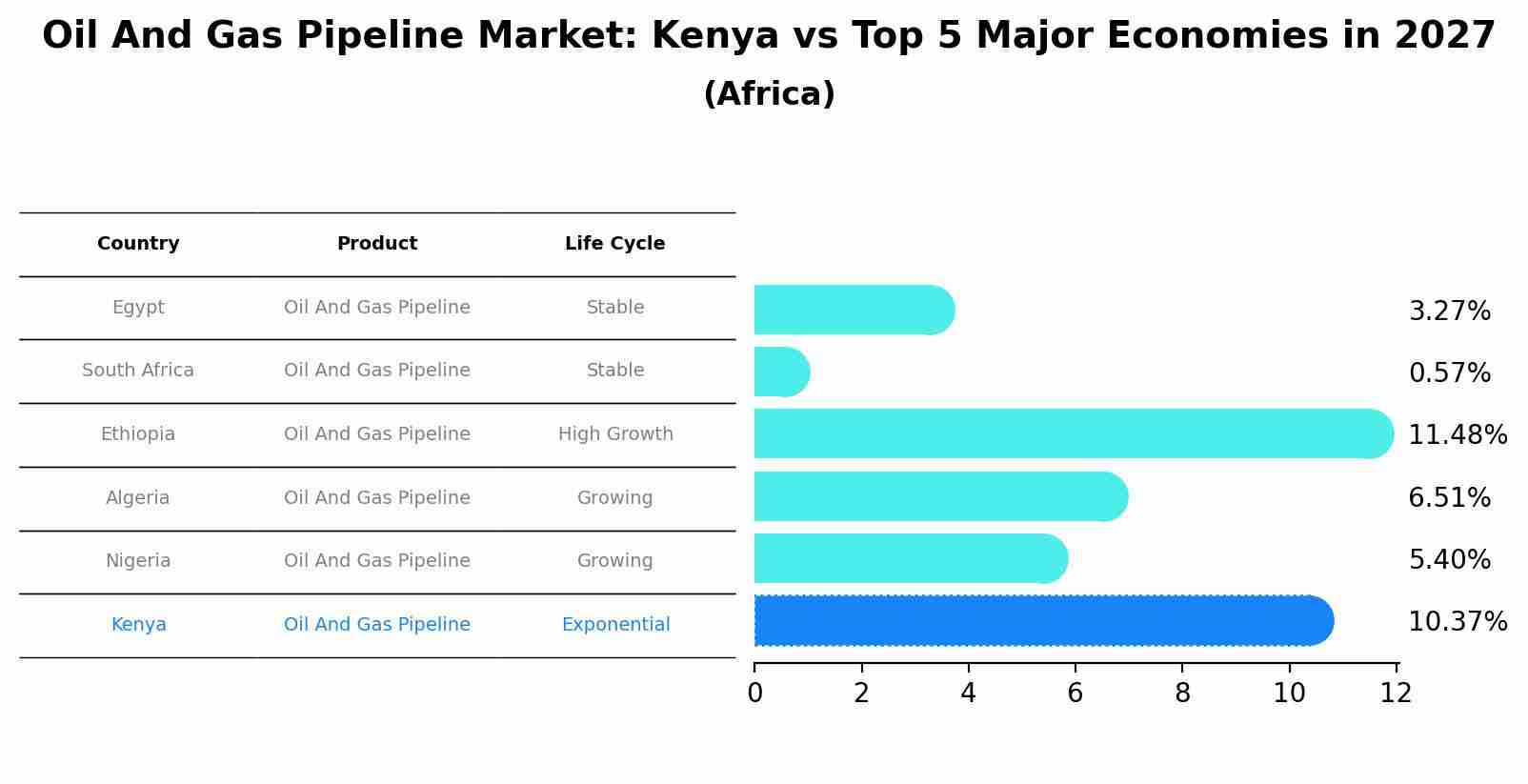Kenya Oil And Gas Pipeline Market Outlook | Revenue, Companies, Trends, Forecast, Share, Analysis, Industry, COVID-19 IMPACT, Growth, Value & Size
| Product Code: ETC377330 | Publication Date: Aug 2022 | Updated Date: Jul 2025 | Product Type: Market Research Report | |
| Publisher: 6Wresearch | Author: Shubham Padhi | No. of Pages: 75 | No. of Figures: 35 | No. of Tables: 20 |
Kenya Oil And Gas Pipeline Market Size Growth Rate
The Kenya Oil And Gas Pipeline Market is projected to witness mixed growth rate patterns during 2025 to 2029. From 10.19% in 2025, the growth rate steadily ascends to 10.44% in 2029.

Oil And Gas Pipeline Market: Kenya vs Top 5 Major Economies in 2027 (Africa)
In the Africa region, the Oil And Gas Pipeline market in Kenya is projected to expand at a high growth rate of 10.37% by 2027. The largest economy is Egypt, followed by South Africa, Ethiopia, Algeria and Nigeria.

Kenya Oil And Gas Pipeline Market Synopsis
The Kenya Oil and Gas Pipeline Market is experiencing significant growth driven by the country`s expanding oil and gas sector. The market is characterized by the development of new pipeline infrastructure to cater to the increasing demand for transportation of crude oil and natural gas across the region. Key players in the market are investing in the construction of pipelines to enhance the efficiency and reliability of oil and gas transportation. Additionally, government initiatives to promote infrastructure development and attract foreign investments are further fueling the market growth. The market is expected to witness continued expansion in the coming years, driven by the discovery of new oil and gas reserves in the region and the increasing focus on energy security and sustainability.
Kenya Oil And Gas Pipeline Market Trends
The Kenya oil and gas pipeline market is witnessing several trends. One significant trend is the increased investment in pipeline infrastructure to support the transportation of oil and gas resources within the country and to neighboring regions. The government`s focus on expanding the pipeline network to enhance energy security and promote economic growth is driving this trend. Additionally, there is a growing emphasis on incorporating advanced technologies such as monitoring systems and leak detection tools to ensure the safety and efficiency of pipeline operations. Moreover, there is a shift towards developing pipelines that are more environmentally sustainable, with a focus on minimizing the impact on local communities and ecosystems. Overall, the Kenya oil and gas pipeline market is evolving towards more efficient, safe, and sustainable infrastructure development.
Kenya Oil And Gas Pipeline Market Challenges
In the Kenya Oil and Gas Pipeline market, some of the key challenges include regulatory uncertainties, inadequate infrastructure, security concerns, and environmental issues. The regulatory environment in Kenya can be unpredictable, leading to delays in project approvals and implementation. Additionally, the existing pipeline infrastructure may be insufficient to meet the growing demand for oil and gas transportation. Security concerns, such as theft and vandalism, can also pose risks to pipeline operations. Moreover, environmental considerations, including potential spills and impacts on local communities and ecosystems, are critical factors that need to be managed effectively in the development and operation of oil and gas pipelines in Kenya. Addressing these challenges requires close collaboration between industry stakeholders, government bodies, and local communities to ensure the sustainable growth of the oil and gas sector in the country.
Kenya Oil And Gas Pipeline Market Investment Opportunities
The Kenya Oil and Gas Pipeline market offers promising investment opportunities due to the government`s focus on expanding the country`s energy infrastructure. With planned projects such as the Lamu Port-South Sudan-Ethiopia-Transport (LAPSSET) Corridor and the East African Crude Oil Pipeline, there is a growing demand for pipeline construction and maintenance services. Investors can explore opportunities in pipeline construction companies, technology providers for pipeline monitoring and maintenance, and logistics companies that facilitate the transportation of oil and gas products. As Kenya aims to become a regional hub for oil and gas trade, investing in the pipeline sector could offer long-term growth potential and significant returns for investors. Potential risks include regulatory challenges, environmental concerns, and geopolitical factors that may impact project timelines and profitability.
Jordan Agar Market Government Policies
The government of Kenya has implemented various policies to regulate and promote the oil and gas pipeline market in the country. Key policies include the Energy Act, which provides the legal framework for the development and operation of oil and gas infrastructure, and the Petroleum (Exploration and Production) Act, which governs the exploration, production, and transportation of oil and gas resources. Additionally, the government has established the Energy Regulatory Commission (ERC) to oversee the licensing and regulation of oil and gas infrastructure, ensuring compliance with safety and environmental standards. These policies aim to attract investment, promote efficient operations, and ensure the sustainable development of Kenya`s oil and gas pipeline market.
Kenya Oil And Gas Pipeline Market Future Outlook
The future outlook for the Kenya Oil and Gas Pipeline Market appears promising, with significant growth opportunities expected in the coming years. The market is likely to be driven by ongoing investments in infrastructure development, increasing oil and gas exploration activities, and the country`s efforts to enhance its energy security. Additionally, the discovery of new oil and gas reserves in the region is expected to boost the demand for pipeline infrastructure to transport these resources efficiently. With Kenya positioning itself as a regional hub for oil and gas trade, the market is projected to witness substantial growth, attracting both domestic and international investments. Overall, the Kenya Oil and Gas Pipeline Market is poised for expansion, offering lucrative prospects for industry players and stakeholders.
Key Highlights of the Report:
- Kenya Oil And Gas Pipeline Market Outlook
- Market Size of Kenya Oil And Gas Pipeline Market, 2021
- Forecast of Kenya Oil And Gas Pipeline Market, 2031
- Historical Data and Forecast of Kenya Oil And Gas Pipeline Revenues & Volume for the Period 2018 - 2031
- Kenya Oil And Gas Pipeline Market Trend Evolution
- Kenya Oil And Gas Pipeline Market Drivers and Challenges
- Kenya Oil And Gas Pipeline Price Trends
- Kenya Oil And Gas Pipeline Porter's Five Forces
- Kenya Oil And Gas Pipeline Industry Life Cycle
- Historical Data and Forecast of Kenya Oil And Gas Pipeline Market Revenues & Volume By Location of Deployment for the Period 2018 - 2031
- Historical Data and Forecast of Kenya Oil And Gas Pipeline Market Revenues & Volume By Onshore for the Period 2018 - 2031
- Historical Data and Forecast of Kenya Oil And Gas Pipeline Market Revenues & Volume By Offshore for the Period 2018 - 2031
- Historical Data and Forecast of Kenya Oil And Gas Pipeline Market Revenues & Volume By Type for the Period 2018 - 2031
- Historical Data and Forecast of Kenya Oil And Gas Pipeline Market Revenues & Volume By Crude Oil Pipeline for the Period 2018 - 2031
- Historical Data and Forecast of Kenya Oil And Gas Pipeline Market Revenues & Volume By Gas Pipeline for the Period 2018 - 2031
- Kenya Oil And Gas Pipeline Import Export Trade Statistics
- Market Opportunity Assessment By Location of Deployment
- Market Opportunity Assessment By Type
- Kenya Oil And Gas Pipeline Top Companies Market Share
- Kenya Oil And Gas Pipeline Competitive Benchmarking By Technical and Operational Parameters
- Kenya Oil And Gas Pipeline Company Profiles
- Kenya Oil And Gas Pipeline Key Strategic Recommendations
Frequently Asked Questions About the Market Study (FAQs):
- Single User License$ 1,995
- Department License$ 2,400
- Site License$ 3,120
- Global License$ 3,795
Search
Related Reports
- ASEAN Bearings Market (2025-2031) | Strategy, Consumer Insights, Analysis, Investment Trends, Opportunities, Growth, Size, Share, Industry, Revenue, Segments, Value, Segmentation, Supply, Forecast, Restraints, Outlook, Competition, Drivers, Trends, Demand, Pricing Analysis, Competitive, Strategic Insights, Companies, Challenges
- Europe Flooring Market (2025-2031) | Outlook, Share, Industry, Trends, Forecast, Companies, Revenue, Size, Analysis, Growth & Value
- Saudi Arabia Manlift Market (2025-2031) | Outlook, Size, Growth, Trends, Companies, Industry, Revenue, Value, Share, Forecast & Analysis
- Uganda Excavator, Crane, and Wheel Loaders Market (2025-2031) | Strategy, Consumer Insights, Analysis, Investment Trends, Opportunities, Growth, Size, Share, Industry, Revenue, Segments, Value, Segmentation, Supply, Forecast, Restraints, Outlook, Competition, Drivers, Trends, Demand, Pricing Analysis, Competitive, Strategic Insights, Companies, Challenges
- Rwanda Excavator, Crane, and Wheel Loaders Market (2025-2031) | Strategy, Consumer Insights, Analysis, Investment Trends, Opportunities, Growth, Size, Share, Industry, Revenue, Segments, Value, Segmentation, Supply, Forecast, Restraints, Outlook, Competition, Drivers, Trends, Demand, Pricing Analysis, Competitive, Strategic Insights, Companies, Challenges
- Kenya Excavator, Crane, and Wheel Loaders Market (2025-2031) | Strategy, Consumer Insights, Analysis, Investment Trends, Opportunities, Growth, Size, Share, Industry, Revenue, Segments, Value, Segmentation, Supply, Forecast, Restraints, Outlook, Competition, Drivers, Trends, Demand, Pricing Analysis, Competitive, Strategic Insights, Companies, Challenges
- Angola Excavator, Crane, and Wheel Loaders Market (2025-2031) | Strategy, Consumer Insights, Analysis, Investment Trends, Opportunities, Growth, Size, Share, Industry, Revenue, Segments, Value, Segmentation, Supply, Forecast, Restraints, Outlook, Competition, Drivers, Trends, Demand, Pricing Analysis, Competitive, Strategic Insights, Companies, Challenges
- Israel Intelligent Transport System Market (2025-2031) | Strategy, Consumer Insights, Analysis, Investment Trends, Opportunities, Growth, Size, Share, Industry, Revenue, Segments, Value, Segmentation, Supply, Forecast, Restraints, Outlook, Competition, Drivers, Trends, Demand, Pricing Analysis, Competitive, Strategic Insights, Companies, Challenges
- Uganda Precast and Aggregate Market (2025-2031) | Strategy, Consumer Insights, Analysis, Investment Trends, Opportunities, Growth, Size, Share, Industry, Revenue, Segments, Value, Segmentation, Supply, Forecast, Restraints, Outlook, Competition, Drivers, Trends, Demand, Pricing Analysis, Competitive, Strategic Insights, Companies, Challenges
- Australia IT Asset Disposal Market (2025-2031) | Strategy, Consumer Insights, Analysis, Investment Trends, Opportunities, Growth, Size, Share, Industry, Revenue, Segments, Value, Segmentation, Supply, Forecast, Restraints, Outlook, Competition, Drivers, Trends, Demand, Pricing Analysis, Competitive, Strategic Insights, Companies, Challenges
Industry Events and Analyst Meet
Our Clients
Whitepaper
- Middle East & Africa Commercial Security Market Click here to view more.
- Middle East & Africa Fire Safety Systems & Equipment Market Click here to view more.
- GCC Drone Market Click here to view more.
- Middle East Lighting Fixture Market Click here to view more.
- GCC Physical & Perimeter Security Market Click here to view more.
6WResearch In News
- Doha a strategic location for EV manufacturing hub: IPA Qatar
- Demand for luxury TVs surging in the GCC, says Samsung
- Empowering Growth: The Thriving Journey of Bangladesh’s Cable Industry
- Demand for luxury TVs surging in the GCC, says Samsung
- Video call with a traditional healer? Once unthinkable, it’s now common in South Africa
- Intelligent Buildings To Smooth GCC’s Path To Net Zero













